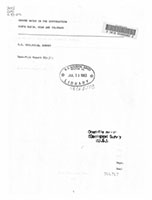Ground water in the southeastern Uinta Basin, Utah and Colorado
Links
- Document: Report (pdf)
- Figure: Figure (pdf)
- Superseding Publications:
- Download citation as: RIS | Dublin Core
Abstract
The potential for developing oil-shale resources in the southeastern Uinta Basin of Utah and Colorado has created the need for information on the quantity and quality of water available in the area. This report describes the availability and chemical quality of ground water, which might provide a source or supplement of water supply for an oil-shale industry.
Ground water in the southeastern Uinta Basin occurs in three major aquifers. Alluvial aquifers of small areal extent are present in valley-fill deposits of six major drainages. Consolidated-rock aquifers include the bird's-nest aquifer in the Parachute Creek Member of the Green River Formation, which is limited to the central part of the study area; and the Douglas Creek aquifer, which includes parts of the Douglas Creek Member of the Green River Formation and parts of the intertonguing Renegade Tongue of the Wasatch Formation; this aquifer underlies most of the study area.
The alluvial aquifers are recharged by infiltration of streamflow and leakage from consolidated-rock aquifers. Recharge is estimated to average about 32,000 acre-feet per year. Discharge from alluvial aquifers, primarily by evapotranspiration, also averages about 32,000 acre-feet per year. The estimated volume of recoverable water in storage in alluvial aquifers is about 200,000 acre-feet. Maximum yields to individual wells are less than 1,000 gallons per minute.
Recharge to the bird's-nest aquifer, primarily from stream infiltration and downward leakage from the overlying Uinta Formation, is estimated to average 670 acre-feet per year. Discharge from the bird's-nest aquifer, which is primarily by seepage to Bitter Creek and the White River, is estimated to be 670 acre-feet per year. The estimated volume of recoverable water in storage in the bird's-nest aquifer is 1.9 million acre-feet. Maximum yields to individual wells in some areas may be as much as 5,000 gallons per minute.
A digital-computer model of the flow system was used to evaluate the effects of oil-shale development on the bird's-nest aquifer at the Federal lease tracts Ua and Ub. Results of model simulations indicate that during construction of a vertical access shaft, a pumping rate of about 900 gallons per minute would be required to dewater the aquifer. The model also indicates that the construction of a proposed reservoir on the White River may raise water levels in the bird's-nest aquifer near the reservoir site by as much as 45 feet.
The flow model was used to evaluate the potential ground-water supply available for oil-shale development in the vicinity of the Federal lease tracts Ua and Ub. The results of the simulation indicate that the bird's-nest aquifer could supply about 10,000 acre-feet of water per year at that site, for a period of 20 years. Drawdown after 20 years of pumping would exceed 250 feet near the simulated well field. Based on the results of the model simulation, it is estimated that the aquifer could simultaneously supply another 10,000 acre-feet of water per year in the northern part of the study area, but some interference between well fields could be expected.
The Douglas Creek aquifer is recharged by precipitation and stream infiltration at an average rate of about 20,000 acre-feet per year. Discharge is estimated to be about the same and is primarily through springs and diffuse seepage. The estimated volume of recoverable water in storage is 16 million acre-feet. Maximum yields to individual wells are estimated to be less than 500 gallons per minute.
Study Area
| Publication type | Report |
|---|---|
| Publication Subtype | USGS Numbered Series |
| Title | Ground water in the southeastern Uinta Basin, Utah and Colorado |
| Series title | Open-File Report |
| Series number | 83-271 |
| DOI | 10.3133/ofr83271 |
| Year Published | 1983 |
| Language | English |
| Publisher | U.S. Geological Survey |
| Publisher location | Reston, VA |
| Description | Report: 138 p.; 1 Plate: 21.65 x 29.42 inches |
| Country | United States |
| State | Colorado, Utah |
| Other Geospatial | Uinta Basin |


